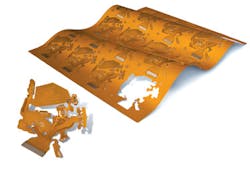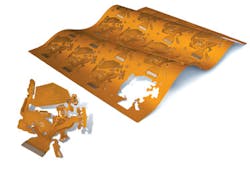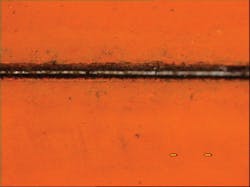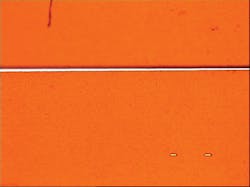Shane Stafford
UV laser cutting is emerging as the choice option in flexible circuit cutting above traditional mechanical methods
Flexible printed circuits (FPC) allow design versatility not possible with traditional rigid circuit boards. Building circuits on flexible materials allows for new applications that push the limits, including versatile multilayer capabilities and solutions for the astronautic, telecommunication, and medical industries, to name a few.
Current trends in the FPC industry are all about reduction, as designers seek to shrink circuit size while simultaneously reducing factors that limit mounting density, or the distance between circuits on a panel. Meeting these demands often requires arbitrary contour shaping, as basic square circuits are too inelastic to fit the requirements of many modern applications.
These design demands introduce application challenges, including the issue of depanelization, or the process of removing circuits from panels. How can smaller, arbitrary circuits with high mounting density be cut accurately without damaging components or the circuit itself? Flex circuit materials are unique in that even the smallest amount of stress exerted on the circuit during the cutting process can cause such damage.
Accommodating for this damage limits design versatility. A space for cushion around each cut must be factored into the design, meaning cut widths will be wider than desired, components cannot be placed close to the edge of the board or each other, and shaping cannot be as intricate as desired. Without a viable solution to this issue, limitation would trump innovation as accommodating unsatisfactory depaneling methods would become the predominant design concern.
Traditional mechanical depaneling methods such as die punching and routing yield inadequate results in this regard, with large cut widths and stressors too extreme for intricate flex circuits. Even CO2 laser cutting follows a similar unsatisfactory pattern in this regard, due to a resulting large heat-affected zone.
One technology, however, has risen to the challenge when it comes to FPC depaneling: ultraviolet (UV) laser cutting. By eliminating the physical stress of the mechanical process and greatly reducing the thermal stress of the CO2 UV lasers make it possible to meet the design trends described above. Exploring these and other factors reveals why UV laser cutting has emerged as the choice option when it comes to flex circuit cutting.
Circuit stress and cut widths
All flex cutting methods impose some stress on the circuit. Differences arise in the type of stress being induced and the degree to which stress affects the circuit. Taking into consideration the aforementioned depaneling methods, there are two possible types of stress a flex printed circuit may experience when being cut: mechanical stress or thermal stress.
Mechanical stress occurs when employing mechanical depaneling methods such as die punching or routing. Effects on flex circuits stemming from mechanical stress include burring, deformation, and damage to circuit components. These effects are too extreme for flex materials to handle. Die punching, for example, is a high-impact process that shakes the circuit, damaging components and requiring a sizable cut cushion. Typical FPC cut widths for die punching and routing measure 1 mm, a number too large for the intricate and arbitrary nature of many flex circuits. The results of such a wide cut include diminished mounting density, or a reduction in the number of circuits fit to each panel. In an age where flexible printed circuits are becoming smaller and more condensed, this raises both technical and cost concerns.
With mechanical depaneling methods unable to meet the standards of flex design, users can turn next to laser cutting options, which produce a different type of effect on the circuit: thermal stress. The effects of thermal stress are fundamentally different from those of mechanical stress, given that the laser beam does not make physical contact with the circuit - in this regard, laser cutting could be more accurately described as laser ablation. Burning and inconsistent kerfing (cut width) are the most common effects of thermal stress. However, these effects are much more prevalent in pulsed CO2 laser systems, which have high-energy-density power sources and employ use of lasers with wavelengths in the warmer, more absorbent IR spectrum. UV laser systems, on the other hand, feature thermally cool UV lasers that operate at lower energy levels, keeping the effects of thermal stress to a minimum.
Looking at an application, FIGURE 2 and FIGURE 3 display 125 μm thick Kapton that has been cut by a CO2 laser and a UV laser, respectively. Both laser sources feature a 20 μm beam size. In this case, the higher energy CO2 laser produces a very hot cut, with severe burning and deformation resulting from the stress exacted on the material. As an outcome of the stress incurred, the effective cut width is extended to 120 μm. While this number is significantly narrower than the 1 mm cut width of mechanical depaneling methods, the cut is uneven and poor in quality.
When the same material is cut by a UV laser system, the reduction in thermal energy produces a "cold" cut (also known as cold ablation) and accounts for a virtually stress-free incision. The result is a 30 μm cut width and a smooth, vertical cut edge.
Reducing the amount of stress exerted on the circuit is crucial to cutting polyimide and other flex materials. Due to its low-power nature, UV laser cutting guarantees maximum dimensional integrity on FPC cuts, leaving them clean and straight.
Applying the technology
UV laser systems cut nearly every circuit material, flex or otherwise. Common flex applications include polyimides such as Kapton, PET materials such as Akaflex, and combination materials such as Pyralux. UV laser systems also can process nearly all rigid materials for rigid-flex applications. Common applications include FR4 and other epoxy laminates, Rogers materials, ceramics, PTFE, aluminum, and copper.
The UV laser beam is cone shaped, meaning the deeper it must penetrate into a material, the wider the resulting cut will be. Typical cut widths range from 25-50 μm. Repetition accuracy of top UV laser systems reaches ±4 μm, ensuring that designs are cut with the utmost precision.
UV laser cutting speeds depend on the material being processed. The Kapton application shown in FIGURE 3 was cut at a speed of 95 mm/s, approximately 2-3× faster than routing could have achieved, all while eliminating the hazardous stressors that result from other flex depaneling methods.
When considering other capabilities of UV laser depaneling systems (cover layer cutting, skiving, drilling, surface etching), it is no surprise that demand for UV laser systems has skyrocketed in recent years.
Meeting trends
Benefitting from UV laser technology, flex circuit designers can explore utilizing the most intricate and arbitrary of designs. With innovation no longer stymied by technological limitations, traditional circuit shapes and sizes can be challenged.
As a result of the narrow, clean cuts that UV laser systems perform, circuit components can be placed closer to each other and nearer the edge of the circuit. In addition, UV laser cutting ensures that mounting density is maximized and bridge space between circuits shrinks, leaving panels filled to potential.
With the emergence of UV laser cutting, finding the right option for flex depaneling has become easy. In addition to its versatility of applications, the reduction in stress exerted on the board, narrow cut widths, and a precise surgical nature make UV laser cutting the right option for those looking for flex depaneling solutions.
Shane Stafford ([email protected]) is a market development representative with LPKF Laser & Electronics North America, Tualatin, OR.



